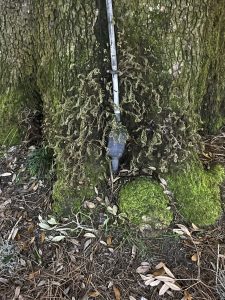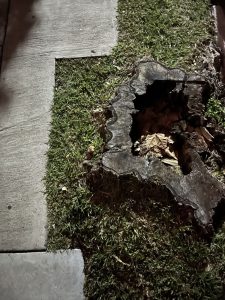Abigail Sturdevant – Nature Finds a Way
Abigail Sturdevant
My photovoice participant is my friend Sarah, she currently goes to school at the College of Charleston and lives in Charleston, South Carolina. She has consented to letting me use her images and statements.

“If you have been outside for any reasonable amount of time, you would know that things will live just about anywhere they can. This photo is that of a hole in the wall of the dorm I live in, with some electronics in view as well as a dying plant. I live in the coastal city of Charleston, SC, where the old city and architecture seems to take precedence over some of the environmental issues. Of course, there are efforts being made in the marshes as well as beaches that are here in the coast of South Carolina but I believe that not enough effort is being promoted in this nation, let alone this city. To me, this photo best illustrates the idea that nature will always try to find a way to make it back. Despite all the cement and electricity, nature finds a way to crawl into the crevices of the modern world.” – Sarah Mariani
This picture and Sarah’s statement reflects on the resilience of nature in urban environments, using a photo of a hole in the dorm wall as an illustrative example. She observes that life persists in unexpected places, with electronics and a struggling plant visible in the photograph. The coastal city’s historic architecture appears to overshadow environmental concerns, despite some conservation efforts in the marshes and beaches. Sarah expresses a belief that insufficient attention is given to environmental issues at both the national and local levels. The photo serves as a poignant representation of nature’s persistent ability to reclaim spaces, highlighting the contrast between the modern infrastructure of cement and electricity and the tenacity of the natural world finding its way into the crevices of urban life.

“As you may or may not know, technology is just about every corner we see. In this photo, we can clearly see some covered wires running along the trunk of a tree, with moss growing all about the tree as well. When I think of the environment and health, I think of nature and how healthy it is within an area. I think this photo is a good representation of how people do their best to input some very unnecessary items or “features” to the world that we live in. This wire was to power some decorative hanging lights in the area. While, yes, the lights may look pretty at night, it is highly unnecessary. The wires themselves having nature grown over it allows for a much more solidified idea that nature is not meant to be worked over and that it will get back. ” – Sarah Mariani
Sarah again wanted to highlight the fact that nature will always find a way back and reflected on the pervasive presence of technology in our surroundings, using a photo to illustrate the intrusion of covered wires on a tree trunk. Moss growing around the tree serves as a visual reminder of the natural environment. She emphasizes the connection between environmental health and the intrusion of unnecessary human-made elements. In this case, the wires were installed to power decorative hanging lights, which the author deems as uneeded. Despite the attempt to incorporate these features, the photo suggests that nature has its way of reclaiming and thriving. The overgrowth of moss on the wires reinforces the idea that nature resists human interventions, providing a thought-provoking commentary on the balance between technology and the natural world.

“Having an ever-growing society, people want more room! Us humans feel like space is everything. Need some phone lines to go through some more rural areas? Let’s cut down some chunks for much easier access to set it all up! A forest or two in the way of creating a mall? Papers signed, done and gone! To me, this image of the remnants of a tree trunk with some sidewalk on the side wholly represents how we as people always tend to try to mow through anything and everything in our way out of convenience for ourselves. There is nothing above this tree trunk, only a sidewalk to one side while there is a street curb on the other. Finding some way to create empty space, for no real reason than to just have it, seems to be something that people just would prefer for the aesthetic of places. This, I would say, is damaging to the world and it’s overall health as taking up so much space- most of it, mind you, becoming uninhabited due to the rising economy- is just hurting both us and the environment. I believe to further allow the environment to fully grow and recover, we have to let it rest. Of course, that is highly unlikely from us but it is also highly unlikely that nature will ever quit thriving.” – Sarah Mariani
Sarah’s last photo and statement critiques the relentless expansion of human society at the expense of natural spaces. Sarah uses the image of a tree trunk’s remnants surrounded by a sidewalk to symbolize humanity’s tendency to clear obstacles for convenience and aesthetic purposes. This highlights instances where urban development takes precedence over environmental conservation, whether it be cutting down trees for infrastructure or clearing forests for commercial spaces. Sarah expresses concern about the negative impact on both the world and its overall health, attributing this to the constant quest for more space, often left uninhabited due to economic trends. Despite acknowledging the unlikelihood of humans allowing the environment to rest, she concludes by emphasizing nature’s resilient ability to thrive, even in the face of ongoing human interventions.
After going over the images and the statements I concluded the overall theme revolves around the intricate relationship between human development, technology, and the natural environment. It delves into the consequences of urbanization, technological advancement, and the human tendency to prioritize convenience and aesthetics over ecological preservation. These statements emphasize the impact of these choices on the health of the environment and suggests a need for greater consideration and balance between human activities and the resilience of nature. Additionally, there is a recurring theme of nature’s ability to persist and reclaim spaces despite human interventions, highlighting the inherent connection between the two.
A reading from the class that relates to Sarah’s photos and statements is module 1 which is “Encountering the Environmental Humanities.” This module goes over environmental humanities as a whole but what really related it to these pictures and statements is when it talked about how different parts of the world view environmental humanities, some places viewing humans as more important than the environment. This really relates to the statements and overall theme, specifically statement 3 when Sarah states, “Finding some way to create empty space, for no real reason than to just have it, seems to be something that people just would prefer for the aesthetic of places.” This shows that in some places humans and their aesthetic purposes really are considered more important than the environment.
Media Attributions
- pic 1
- pic 2
- pic 3

